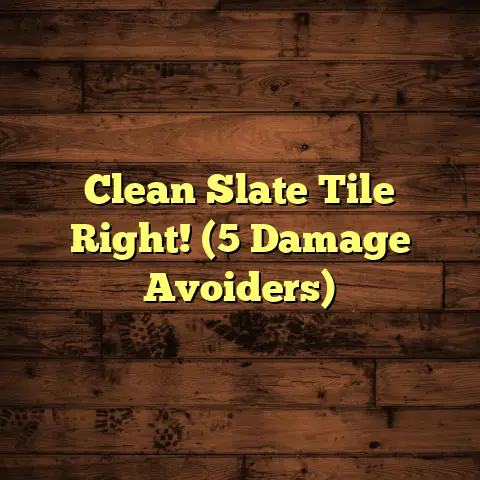Laminate Flooring: Worth It? (5 Things!)
Why? Because it offers a blend of affordability, style, and practicality that’s hard to beat.
But is it really worth it?
Let’s dive into the nitty-gritty of laminate flooring, covering everything from its durability to its environmental impact, so you can decide if it’s the right choice for your home.
Let’s get started!
Introduction: The Rise of Eco-Friendly Flooring
These days, everyone’s talking about “going green,” and that includes what we put on our floors.
The flooring industry has seen a surge in eco-conscious options, and laminate is right there in the mix.
But what makes laminate “eco-friendly,” you ask? Well, it often incorporates recycled materials in its core and uses low-VOC (volatile organic compounds) finishes.
This is a big deal because VOCs can be harmful to your health and the environment. Compared to traditional hardwood, which requires cutting down mature trees, laminate can be a more sustainable choice.
It mimics the look of wood without depleting our forests at the same rate.
The question is, does this eco-friendliness come at the expense of quality or aesthetics?
We’ll explore that and more as we uncover whether laminate flooring is a worthwhile investment for today’s homeowner.
Section 1: Durability and Maintenance
Okay, let’s talk toughness.
One of the biggest selling points of laminate flooring is its durability. I’ve seen it hold up remarkably well in busy households.
Laminate is designed to resist scratches, dents, and even moisture. That protective layer on top? It’s a game-changer.
Think about it: kids, pets, clumsy adults (we’ve all been there!).
Laminate can handle the daily wear and tear that would wreak havoc on other flooring types.
Laminate vs. The Competition
How does it stack up against other options like hardwood and tile?
-
Hardwood: Beautiful, yes, but also susceptible to scratches and water damage. Requires regular refinishing.
-
Tile: Super durable, but can be cold and hard underfoot. Also, grout lines can be a pain to clean.
-
Laminate: A sweet spot between the two. It offers good durability, is easier on the feet than tile, and doesn’t need the constant upkeep of hardwood.
Maintenance Made Easy
When it comes to maintenance, laminate is a breeze.
Regular sweeping or vacuuming is usually enough to keep it looking its best.
For spills, a damp mop with a mild cleaner will do the trick.
No need for special waxes or polishes here!
Lifespan and Warranties
How long can you expect your laminate floor to last? With proper care, a good quality laminate floor can easily last 15-20 years, or even longer.
Many manufacturers offer warranties ranging from 10 years to a lifetime, which shows their confidence in the product’s durability.
Pro Tip: Always read the warranty carefully to understand what’s covered and what’s not.
Section 2: Cost-Effectiveness
Let’s get down to brass tacks: how much will this actually cost you?
One of the most appealing aspects of laminate flooring is its affordability.
Compared to hardwood, stone, or even some types of tile, laminate is significantly cheaper upfront.
According to recent industry data, laminate flooring can cost anywhere from $2 to $8 per square foot, while hardwood can range from $5 to $15 per square foot.
That’s a substantial difference, especially if you’re flooring a large area.
The Long-Term View
But the initial cost is just one piece of the puzzle.
Think about the long-term financial benefits.
Laminate requires less maintenance than hardwood, saving you money on cleaning products and professional services.
It’s also more resistant to damage, reducing the likelihood of costly repairs.
And let’s not forget about resale value. While laminate might not add as much value as hardwood, a well-maintained laminate floor can still be a selling point for potential buyers.
Real-World Examples
I’ve worked with countless homeowners who chose laminate for its cost-effectiveness.
For example, I had a client who was renovating a rental property on a tight budget.
They opted for laminate flooring throughout the house and were thrilled with the results.
It looked great, was easy to clean between tenants, and didn’t break the bank.
Energy Savings
Here’s something you might not have considered: laminate can actually contribute to energy savings.
It provides a layer of insulation, helping to keep your home warmer in the winter and cooler in the summer.
This can translate to lower energy bills, which is a win-win for your wallet and the environment.
Section 3: Aesthetic Variety
Okay, so laminate is durable and affordable, but what about looks?
Can it really compete with the beauty of natural materials?
The answer is a resounding YES!
Laminate flooring has come a long way in recent years.
Thanks to advancements in printing technology, it can now mimic the look of wood, stone, and even tile with incredible realism.
You can find laminate flooring in a wide range of styles, colors, and finishes to suit any taste.
Whether you prefer the rustic charm of reclaimed wood or the sleek elegance of marble, there’s a laminate option for you.
Complementing Your Style
One of the great things about laminate is its versatility.
It can complement a variety of interior design styles, from traditional to contemporary.
-
Farmhouse: Choose a laminate with a distressed wood look.
-
Modern: Opt for a sleek, gray-toned laminate.
-
Coastal: Go for a light, beachy wood grain.
DIY Installation
Here’s another way laminate can save you money: it’s relatively easy to install yourself.
Many laminate floors feature a click-lock system, which allows you to snap the planks together without glue or nails.
If you’re handy with tools and have some DIY experience, you can tackle the installation yourself and save on labor costs.
But be warned: proper subfloor preparation is crucial for a successful installation.
Make sure your subfloor is level, clean, and dry before you start laying the laminate.
Designer’s Perspective
I often collaborate with interior designers, and they’re consistently impressed with the aesthetic possibilities of laminate flooring.
One designer I work with told me, “Laminate has become a go-to for my clients who want the look of hardwood without the high price tag.
The variety of styles and finishes available allows me to create stunning designs that fit their budget.”
Section 4: Comfort and Noise Reduction
Now, let’s talk about how laminate feels and sounds.
Comfort is subjective, but most people find laminate to be reasonably comfortable underfoot.
It’s not as soft as carpet, but it’s also not as hard as tile or concrete.
The texture of the laminate can also play a role in its comfort level.
Some laminates have a slightly textured surface that provides better traction and feels more pleasant to walk on.
Sound Absorption
One of the potential downsides of laminate flooring is that it can be a bit noisy.
Footsteps can sound louder on laminate than on carpet or hardwood.
However, there are ways to mitigate this issue.
The key is underlayment.
The Power of Underlayment
Underlayment is a thin layer of material that goes between the subfloor and the laminate flooring.
It provides cushioning, reduces noise, and helps to smooth out any imperfections in the subfloor.
When it comes to noise reduction, look for an underlayment that is specifically designed for that purpose.
These underlayments often have a higher density and better sound-absorbing properties.
Pro Tip: Consider using a thicker underlayment for even better comfort and noise reduction.
User Experiences
I’ve had clients tell me that adding a quality underlayment made a huge difference in the comfort and acoustics of their laminate floors.
One client said, “I was worried that the laminate would be too noisy, but the underlayment made it surprisingly quiet.
It’s also much more comfortable to walk on than I expected.”
Section 5: Environmental Impact
Let’s circle back to the “green” factor.
As I mentioned earlier, laminate flooring can be an eco-friendly choice, but it’s important to understand the nuances.
Sourcing and Certifications
Look for laminate flooring that is made from recycled materials and sourced from sustainably managed forests.
Certifications like FSC (Forest Stewardship Council) and Greenguard can help you identify products that meet certain environmental standards.
FSC certification ensures that the wood used in the laminate comes from responsibly managed forests.
Greenguard certification indicates that the product has low VOC emissions.
Comparing Footprints
When comparing the environmental footprint of laminate flooring with other materials, consider factors such as energy consumption during production, transportation, and end-of-life disposal.
Laminate generally has a lower environmental impact than hardwood, as it uses less virgin wood and can be made from recycled materials.
However, it’s important to note that some laminate floors are made with formaldehyde-based adhesives, which can release harmful VOCs.
Look for laminate flooring that is labeled as “formaldehyde-free” or “low-VOC.”
Manufacturer Responsibility
Manufacturers play a crucial role in promoting sustainable practices in the laminate flooring industry.
Some manufacturers are investing in innovative recycling programs and initiatives aimed at reducing waste.
For example, some companies are working to develop laminate flooring that can be recycled at the end of its life.
Making Informed Choices
As a consumer, you have the power to make informed choices that support sustainable practices.
Do your research, read product labels carefully, and choose laminate flooring that is made from recycled materials, sourced from sustainably managed forests, and has low VOC emissions.
By making conscious choices, you can help to reduce the environmental impact of your flooring project.
Conclusion: Is Laminate Right for You?
So, is laminate flooring worth it?
The answer, as with most things in life, is it depends.
Laminate offers a compelling combination of durability, affordability, aesthetic variety, and comfort.
It’s also a relatively eco-friendly option, especially when compared to some other flooring materials.
However, laminate is not without its drawbacks.
It can be noisy, and it may not add as much resale value to your home as hardwood.
Ultimately, the decision of whether or not to choose laminate flooring depends on your personal circumstances, style preferences, and budget.
Consider your lifestyle, your home’s design, and your long-term goals.
Do your research, compare your options, and choose the flooring that best meets your needs.
By making informed decisions, you can create a beautiful, functional, and sustainable home that you’ll love for years to come.
Remember, your floor is the foundation of your home’s style.
Choose wisely!





